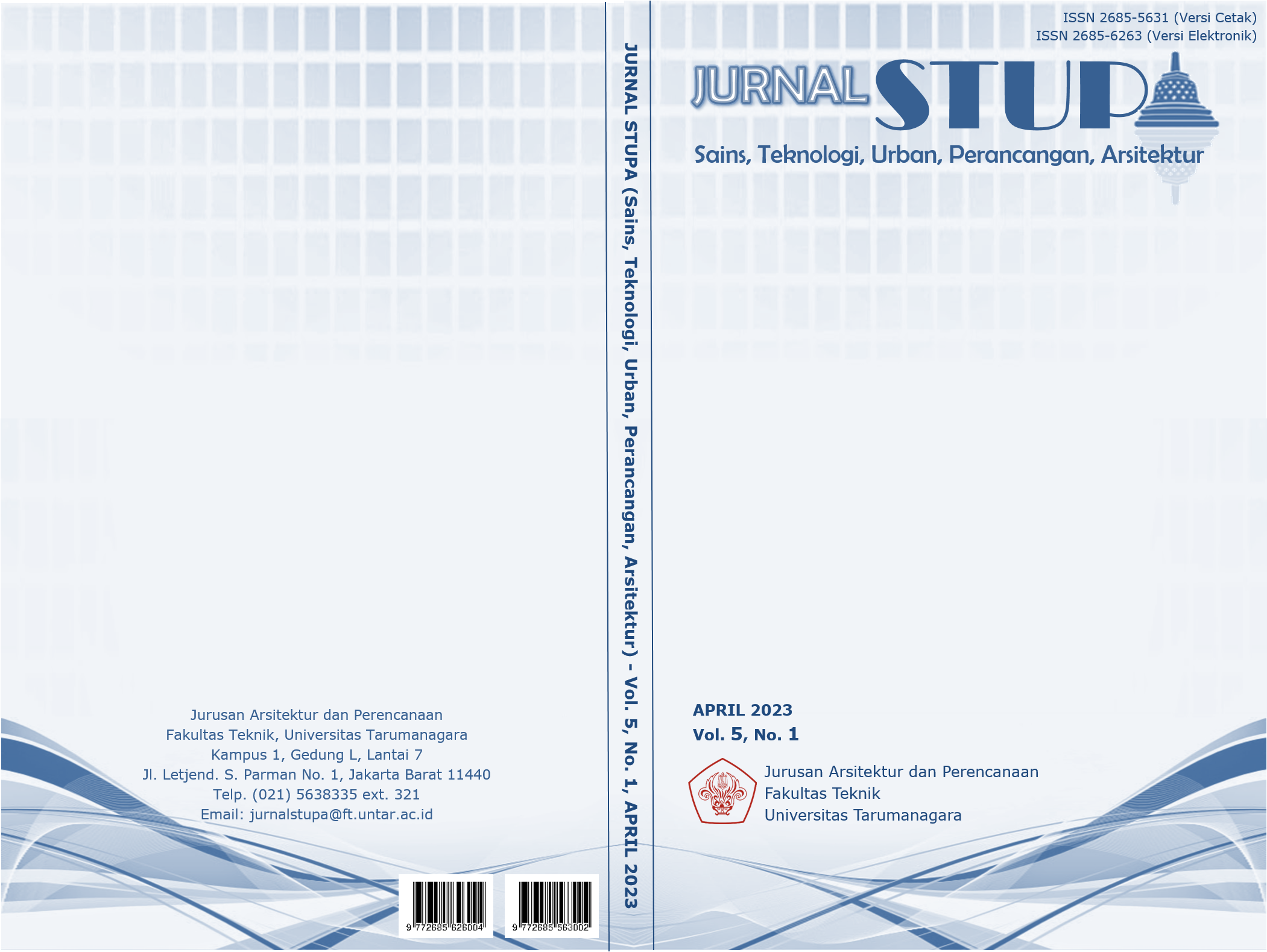DESAIN PASAR TAMAN PURING MELALUI PENDEKATAN KONTEKSTUAL
Main Article Content
Abstract
Acknowledging the importance of the market sector’s big role in a city. The existence of Taman Puring Market has a big influence on the daily activities of the local population. Thus, the problems that occur with the market are very important and affect the integration of the buying and selling chain as a market for used goods. When the chain is broken, there will be a certain person's welfare, especially market traders. By paying attention to the welfare of traders, Taman Puring Market creates a market for development and advancement of existing ties for the welfare of both sellers and buyers. Taman Puring Market has been known for a long time as a market for cheap shoes and used goods. A very historical Taman Puring Market trip. However, they are in danger of dying because of diminishing visitors due to the increase in the realm of online trading and the addition of the COVID-19 pandemic. Through qualitative methods supported by the Urban Acupuncture strategy with a daily analysis approach which results in the use of contextual concepts that aim to restore the identity and existence of the Taman Puring market as a used goods market realized in accordance with the surrounding context by designing a used goods facade as a support for the used goods market icon so that the market will be can support the surrounding area to develop as well by becoming an attractor that again reminds the importance of the Taman Puring Market and as a forum for market traders to move forward in balancing offline and online markets.
Keywords: market; park; urban acupuncture; used goods
Abstrak
Sektor pasar dalam sebuah kota memiliki peran yang sangat penting. Keberadaan Pasar Taman Puring berpengaruh besar dalam kegiatan keseharian penduduk setempat. Sehingga, permasalahan yang terjadi terhadap pasar sangatlah penting dan berpengaruh pada integrasi rantai jual-beli sebagai pasar barang bekas. Ketika rantai tersebut ada yang terputus akan terjadi adanya ketidaksejahteraan suatu oknum tertentu khususnya pedagang pasar. Dengan memperhatikan kesejahteraan pedagang Pasar Taman Puring mewujudkan pasar untuk berkembang dan majunya ikatan yang ada untuk kesejahteraan penjual maupun pembelinya. Pasar Taman Puring dikenal sejak lama sebagai pasar sepatu murah dan barang bekas. Perjalanan Pasar Taman Puring yang sangat historis. Namun, terancam mati karena pengunjung yang kian berkurang akibat meningkatnya ranah perdagangan daring dan ditambah pandemi COVID-19. Melalui metode kualitatif didukung dengan strategi Akupunktur Perkotaan dengan pendekatan analisis keseharian yang menghasilkan digunakannya konsep kontekstual yang bertujuan untuk mengembalikan identitas dan eksistensi pasar taman puring sebagai pasar barang bekas terwujud sesuai dengan konteks sekitar dengan perancangan fasad barang bekas sebagai pendukung ikon pasar barang bekas sehingga pasar nantinya dapat mendukung kawasan sekitarnya untuk ikut berkembang dengan menjadi atraktor yang kembali mengingatkan pentingnya Pasar Taman Puring dan sebagai wadah bagi pedagang pasar untuk ikut maju dalam menyeimbangkan pasar luring dan daring.
Article Details

This work is licensed under a Creative Commons Attribution-NonCommercial-ShareAlike 4.0 International License.
This work is licensed under a Jurnal Sains, Teknologi, Urban, Perancangan, Arsitektur/ STUPA Creative Commons Attribution-NonCommercial-ShareAlike 4.0 International LicenseReferences
Algifari. (2002). Ekonomi Mikro Teori Dan Kasus Edisi Kesatu. 92.
Al-Hinkawi, W., & Al-Saadi, S. (2020). Urban Acupuncture, a Strategy for Development:. IOP Conference Series: Materials Science and Engineering.
Baxter, P., & Jack, S. (2008). Qualitative Case Study Methodology: Study Design and Implementation for Novice Researchers. The Qualitative Report, 13, 544-559.
Bogdan, R., & Biklen, S. (1982). Qualitative Data Analysis : A Sourcebook of New Methods. California: Sage.
Brolin, B. (1980). Architecture in Context: Fitting New Buildings with Old. Melbourne: Van Nostrand Reinhold Company.
Cutieru, A. (2020). Urban Acupuncture: Regenerating Public Space Through Hyper-Local Interventions.
Ervianto, W. (2012). Selamatkan Bumi Melalui Konstruksi Hijau. Yogyakarta: Andi Offset.
Kotler, P., & Amstrong, G. (2013). Prinsip-prinsip Pemasaran. Jakarta: Erlangga.
Lerner, J. (2014). Urban acupuncture / Jaime Lerner; translated from the Portuguese by Mac Margolis, Peter Muello, and Ariadne Daher. Washington [D.C.]; Covelo; London: Island Press.
Morales, D. (2004). The Strategy of Urban Acupuncture: Structure Fabric and Topography Conference. 55-56.
Saleh, T. (2009). Architectural Press. University of Florida.
Schulz, C.-N. (1979). Genius Loci: towards a phenomenology of architecture. New York: Rizzoli.



